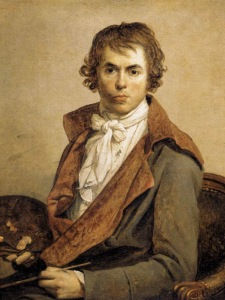(Paris 1748 - Brussels 1825)
The French painter Jacques Louis David was the founder and the most influential painter of the neoclassical style. He was the most outstanding artist during the French Revolution and the First Empire period.
Joseph-Marie Vien took over David’s tutelage after Boucher’s advice. David attended the Royal Academy (1766), won the Prix de Rome (1744) and accompanied his master during a journey to Italy. In Italy, David discovered the ruins of ancient Rome and was influenced by the neoclassical theorists Lessing, Winckelmann and Quatremère de Quincy. His painting Antiochus and Stratonice belongs to this period.
During his second trip to Rome, where he stayed for five years, he learnt the technique of the chiaroscuro (derived from Caravaggio). In Rome he painted Oath of the Horatii (1785, Louvre Museum), and he combined the big compositions with portraits as we can see in Portrait of Count Stanislaw Potocki, Portrait of Geneviève Jacqueline Pecoul (Louvre Museum) as well as with scenes inspired in the ancient history as The Death of Socrates (1787), The Loves of Paris and Helen and The Lictors Bring to Brutus the Bodies of His Sons (1789).
David held important positions in the French Revolution, contributed to the suppression of the Royal Academy and voted for the execution of the king Louis XVI. The Constituent Assembly ordered him The Oath of the Tennis Court. It was an immense composition that he was not able to finish because the great majority of the protagonists were suspects. During that period he also portrayed some revolutionary leaders: Lepelletier de Saint-Fargeau sur son lit de mort and The Death of Marat.
Robespierre and David were friends, and when Robespierre fell, David was arrested and imprisoned in Luxembourg. From the window of his cell, he painted The Garden of Luxemburg (1794, Louvre Museum). David was freed in 1795 and he became a member of the Art Institute and the official portrait artist of Napoleon Bonaparte. David rejected both the position of State Counsellor and Senator to devote himself to the painting of big compositions as The Intervention of the Sabine Women (1799, Louvre Museum). With this artwork, he wanted to teach the ideologically divided French a lesson of tolerance.
During the First Empire period, he became the chamber painter of Napoleon Bonaparte: Napoleon at the Saint-Bernard Pass (1800, Palace of Versailles), The Coronation of Napoleon (1808, Louvre Museum), which was an ambitious work with a hundred portraits, and Distribution of Eagles (1810, Palace of Versailles). In 1814, in his studio he exhibited Leonidas at Thermopylae (Louvre Museum), an artwork in which he worked for fourteen years. The coming of the Restoration caused his exile, and David went to Brussels (1816) where he continued painting. The nudes of David’s last period, Cupid and Psyche (1817) and Mars Being Disarmed by Venus and the Three Graces (1824), announced the nudes of the painter Ingres, who was one of his disciples.
Almost all the works by David are in Paris (Louvre Museum, Petit Palais, Musée Jacquemart-André and École des Beaux-Arts). Some of his artworks are in museums of New York, Berlin, Rome, Vienna and Washington. Gérard, Girodet, Gros and Ingres stand out among David’s large number of disciples.


